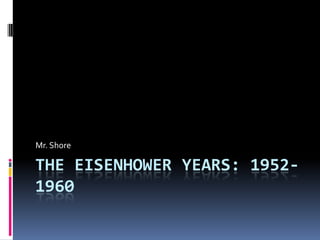
Eisenhower Years
- 1. The Eisenhower Years: 1952-1960 Mr. Shore
- 2. The 50s in the Public Mind Elvis Presley & Early Rock n’ Roll “I Love Lucy” Middle class suburbia, traditional nuclear families—”Father Knows Best”, “Leave it to Beaver” Rosa Parks and black resistance to “Jim Crow” laws The Cold War and the threat of global nuclear destruction
- 3. The Election of 1952 Truman so unpopular he chooses not to run After much internal fighting , Governor Adlai Stevenson is chosen as the Democratic candidate People tired of Democratic rule Republicans choose war hero, General Dwight “Ike” Eisenhower over “Mr. Conservative” Senator Bob Taft Eisenhower—”I shall go to Korea.” Eisenhower wins in a landslide
- 4. Eisenhower-Nixon Ticket Eisenhower chooses the rising star of Senator Richard Nixon of California Nixon is a polarizing personality Nixon is accused of a “slush fund” Nixon famously saves his career in the “Checkers” speech
- 5. Modern Republicanism Acceptance of major New Deal social programs Emphasis on fiscal prudence Eastern, “establishment” Republicans and big business leaders seen as examples of running efficient bureaucracies The major initiative—The Interstate Highway System (good for both commerce and defense)
- 6. Eisenhower’s First Term Steady economic growth Low inflation, high employment Per capita disposable income tripled The US the economic model to the world Extremely popular President—”I like Ike”
- 7. Eisenhower and the Cold War Eisenhower’s important Secretary of State—John Foster Dulles Liberate “captive nations” in Europe and “Red China” Dulles supports “brinksmanship” Greater reliance on nuclear weapons and air power Mutually Assured Destruction (MAD)
- 8. Proxy Wars Direct US-Soviet conflict so dangerous that the competition was fought through indirect or proxy wars India and Pakistan Indonesia Ghana Indochina
- 9. Covert Action Undercover operations by the CIA Helped to establish the pro-American Shah of Iran Overthrow of hostile government in Guatemala Famous anti-American rioting in Venezuela during VP Nixon’s trip to the region
- 10. Asia Korean Armistice in 1953. Heavy and continued US military presence France surrenders Indochina—divided into Cambodia, Laos and Vietnam Vietnam divided into Communist North under Ho Chi Minh; South Vietnam was anti-Communist under Ngo Dinh Diem US supports South Vietnam Concern about advancing Communism—The Domino Theory SEATO
- 11. The Middle East Suez Crisis in 1956 Eisenhower Doctrine—support pro-West, anti-Communist regimes in the Middle East U. S. support of Lebanon Saudi Arabia, Kuwait, Iraq, Iran and Venezuela for an oil cartel—Organization of Petroleum Exporting Countries (OPEC)
- 12. U.S.—Soviet Relations 1955: Geneva Conference to establish “open skies” Soviets reject the proposal New Soviet leader, Nikita Khrushchev Popular Hungarian uprising against the Communist dictatorship Soviets retake Hungary by rolling tanks into the country 1957: Sputnik scare, the race for space
- 13. U.S.—Soviet relations (cont) Second Berlin Crisis in 1958 Khruschev: “We will bury capitalism” (Later: “We will bury you (US)” Soviets demand the US and NATO allies pull out of West Berlin US refuses Camp David meeting in 1959 U-2 incident—the capture of US spy plane Fidel Castro and Communists take over Cuba in 1959
- 14. Civil Rights Formal Segregation throughout the South—”Jim Crow” 1896 Supreme Court ruling, Plessy v. Ferguson establish “separate but equal” doctrine 1954 Supreme Court reverses itself in Brown v. Board of Education Gov. Faubus uses state National Guard to prevent integration of Little Rock Central High School in 1956 Eisenhower calls in Federal troops to enforce federal law
- 15. Civil Rights-Montgomery Bus Boycott Rosa Parks, a black woman, refuses to move to the back of the bus Blacks boycott riding city buses Martin Luther King becomes spokesman for civil rights through nonviolent means Supreme Court rules against state segregation laws Eisenhower supports Civil Rights Acts of 1957 and 1960
- 16. Some Observations on Eisenhower Administration Stable economic conditions America engages the Communist challenge around the world Eisenhower warns of a “military-industrial complex.” Eisenhower supports modest reforms against segregation but declares later that the appointment of Chief Justice Earl Warren was his biggest mistake
- 17. 1950s Culture The growth of television Advertising promotes brand names Suburban shopping centers Credit Cards Mass Consumer Culture—”McDonald’s” Big Business and Big Unions Dr. Benjamin Spock, Baby and Child Care
- 18. Social Criticism The Lonely Crowd, David Reisman The Affluent Society, John Kenneth Galbraith Catcher in the Rye, J. D. Salinger Catch-22, Joseph Heller “Beatniks”
